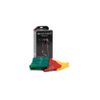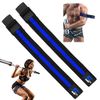
Build and define your triceps using one of the best resistance bands and these five arm exercises.
Sculpting and strengthening your triceps with these moves can be done using a single resistance band or several types, but to get the most out of them, choose a challenging thickness to offer you enough resistance to work your muscles through.
Done properly, your reps shouldn’t be easy to complete, and you’ll get that triceps-trembling feedback quickly. Here’s how to do each exercise, the benefits, the muscles worked and a resistance band arm workout to try.
Which type of resistance band is best?

There’s debate around whether or not resistance bands work. They can, but clever programming will help you squeeze the most out of each move.
We recommend 8-12 reps and 3-4 sets per exercise using a thick band that allows you to work toward a 7-8 out of 10 on the intensity scale; this should help you overload muscles enough during arm workouts.
If you only have a light resistance band, consider programming higher reps toward muscular endurance or moving slower through a full range of motion — a technique known as time under tension.
How you work depends on your goals — endurance, muscle-building, or strengthening. For example, you'll program more reps at lighter loads for endurance-based work and heavier with fewer reps for strength training (read: hypertrophy versus strength training to help you decide how to program).
Sign up to get the BEST of Tom's Guide direct to your inbox.
Here at Tom’s Guide our expert editors are committed to bringing you the best news, reviews and guides to help you stay informed and ahead of the curve!
5 triceps exercises you can do with a resistance band
Build explosive triceps power and hone big triceps with these resistance band exercises.
Resistance band triceps kickbacks

Isolate the triceps by learning how to do kickbacks.
Loop and secure your band around a pull-up bar (or similar) preferably higher than your head. Grip the ends of your band and stand with your feet hip-width apart, with a soft bend in the knees facing the band.
Engage your core, hinge forward at your hips and pull the ends of the band downward behind your hips as you extend your elbows. Keep your arms close to either side of your body, pause, then return to the starting position, allowing your elbows to rebend and your hands to rise.
2. Resistance band JM press
Develop explosive pushing power from the supine position.
If you prefer to have an anchor point, follow the video above and tie your band to a heavy weight behind your head, elevating your upper body on a bench or similar.
We like to perform the exercise on the floor without any other equipment. To do this, wrap a resistance band behind your back, hold each end, then lie on your back. The top of your band should wrap above your shoulders and sit over your upper arms and the bottom of the band should sit over your lats — just like wearing a backpack.
Using an underhand grip, press the band away from you and extend your arms. Pause, then rebend the elbows and lower your hands toward your chest, keeping both elbows pointed toward the front of the room. Press explosively each time, then lower the band with control of every rep.
3. Resistance band push-ups

The resistance band push-up targets the pecs, anterior deltoids and triceps by leveling up push-ups with external resistance.
Make sure you’ve learned how to do push-ups first and you can perform reps unbroken using your knees or on your toes for a full range of motion — chest to the floor.
Secure your band behind your midback and loop the ends of the band over your thumbs. The band should sit over your upper arms. To make it easier, allow your elbows to sit through the band if you're using a looped variety.
Start in the push-up position, shoulders stacked over wrists and hips aligned with shoulders. Brace your core, bend your elbows and lower your chest without dropping your hips. Pause, then drive upward and extend your arms.
4. Resistance band triceps pushdowns
Develop pushing power and isolate your triceps with the simple pushdown.
Secure the band higher than your head using a pull-up bar or similar. Grip on either side of the band with palms facing each other or use an overhand grip over the bottom of the band. Position your feet hip-width apart with knees softly bent. Brace your core, then push the band downward toward your thighs in front of your body. Allow the band to travel upward to the starting position, then repeat.
5. Resistance band diamond push-ups

First, learn how to do diamond push-ups using your knees or on your toes. You should be able to exercise full range of motion by lowering your chest an inch or two off the floor. If you’re not quite there yet, practice resistance band push-ups first and add this push-up variation later.
Wrap your resistance band behind your back with the band sitting against the upper arms or with elbows pointing through the band to make the exercise easier.
Wrap the ends of the bands around your thumbs to secure them, then position your hands in a diamond shape by bringing your thumbs and index fingers to touch. Perform a push-up (as above), keeping your elbows tucked close to your ribs throughout.
Bottom line

Those slices of tricep muscle that run down your upper arms aren’t just for creating a sculpted look. They assist with pushing exercises, elbow extension and backward shoulder extension.
As the name suggests, your triceps have three heads — long, lateral and medial. Your arm positioning, grip and the planes of motion you move in can affect how these muscles are targeted.
For example, pushdowns and diamond push-ups target more of the lateral and long heads, triceps kickbacks and overhead extensions help target the long head and the medial head (the smallest) responds better to endurance-based work (think higher reps, lighter weights), reverse or underhand grips and narrow elbows positions.
Compared with large, powerful muscle groups like the quads or lats, your triceps are a small muscle group, so you can use resistance bands to easily fatigue them as bands hold muscles under tension through all phases of an exercise.
You could also add bodyweight training or mix things up with dumbbells, barbells, or kettlebells to keep your muscles challenged and stimulated. This way, you can play with variables like load and volume while giving your arms a great workout.
Even if you don’t have lots of gym equipment to play with, you can still build muscle without lifting heavy weights — think about giant sets, supersetting moves, or choosing a thicker band.
Remember that diet and lifestyle play a major role in muscle definition, so we recommend reading up on how much protein you need to build muscle and why getting enough sleep matters.
More from Tom's Guide
- 5 of the best exercises to grow your biceps using a resistance band
- This 15-minute arm workout builds your triceps, pecs and shoulders in 15 moves
- Forget sit-ups — you only need 15 minutes and 8 moves to build a stronger core and improve your posture

Sam Hopes is a level 3 fitness trainer, level 2 reiki practitioner, and senior fitness writer at Tom's Guide. She is also currently undertaking her Yoga For Athletes training course. Sam has written for various fitness brands and websites over the years and has experience across brands at Future such as Live Science, Fit&Well, Coach, and T3. Having worked with fitness studios like F45 and Virgin, Sam now primarily teaches outdoor bootcamps, bodyweight and calisthenics, and kettlebells. She also coaches mobility and stretching-focused classes several times a week and believes that true strength comes from a holistic approach to training your body. Sam is currently in training for her next mixed doubles Hyrox competition in London this year, having completed her first doubles attempt in 1:11.






